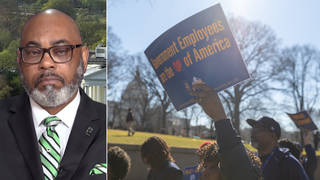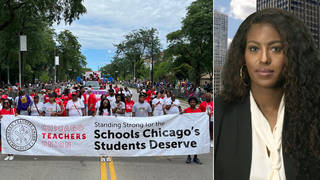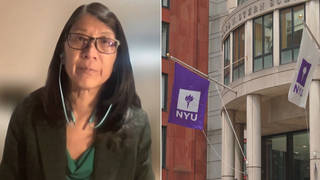
Guests
- Kamran Loghmanhelped develop pepper spray into a weapons-grade material with the FBI in the 1980s. He also helped develop guidelines for police departments using pepper-spray.
We speak with Kamran Loghman, the expert who developed weapons-grade pepper spray, who says he was shocked at how police have used the chemical agent on nonviolent Occupy Wall Street protesters nationwide, including students at University of California, Davis, female protesters in New York City, and an 84-year-old activist in Seattle. “I saw it, and the first thing that came to my mind wasn’t police or students, was my own children sitting down, having an opinion, and their being shot and forced by chemical agents,” says Loghman, who in the 1980s helped the FBI develop weapons-grade pepper spray and collaborated with police departments to develop guidelines for its use. “The use was just absolutely out of ordinary, and it was not in accordance with any training or policy of any department that I know of. I personally certified 4,000 police officers in the early '80s and ’90s, and I've never seen this before. And that’s why I was shocked. That’s why I’ve come up, and I feel it’s my civic duty to explain to the public that this is not what pepper spray was developed for.” [includes rush transcript]
Transcript
AMY GOODMAN: The singer and actress Miley Cyrus, yes, Hannah Montana, a new remix of her song, “Liberty Walk.” Cyrus is showing her support for Occupy Wall Street and international pro-democracy movements by using protest footage from around the world. The video begins with a statement on the screen saying, “This is dedicated to the thousands of people who are standing up for what they believe in.” This is Democracy Now!, democracynow.org, The War and Peace Report. I’m Amy Goodman.
It’s not unprecedented for an inventor to voice regrets when a creation turns out to have harmful uses. It’s widely believed the Swedish industrialist, Alfred Nobel, created the Peace Prize bearing his name in response to feelings of guilt around his invention of dynamite and ballistite, both of which were used in violent acts during his lifetime. The famed physicist Albert Einstein was said to be greatly distressed for unintentionally advancing the development of the atomic bomb through his work.
Today, in the aftermath of the crackdown on Occupy Wall Street protesters nationwide, there’s a new name to add to the list: Kamran Loghman. In the '80s, Loghman was the expert responsible with the FBI in developing weapons-grade pepper spray. He also collaborated with police departments to develop guidelines for pepper spray's use. But now, after seeing footage of police using pepper spray on nonviolent Occupy Wall Street protesters nationwide, including students at UC Davis, protesters with the Occupy movement in New York, and 84-year-old protester Dorli Rainey in Seattle, Kamran Loghman is speaking out against what he calls the most inappropriate and improper use of chemical agents he has ever seen.
Loghman will join us in a minute, but first I want to play an excerpt from when the campus police officers at UC Davis pepper-sprayed students [earlier this] month. The students were sitting down during a peaceful protest when officers began pepper-spraying them at close range.
PROTESTERS: The whole world is watching! The whole world is watching! The whole world is watching!
Shame on you! Shame on you! Shame on you! Shame on you!
PROTESTER: I want your name! I want his name! What’s his name? Pike. Pike!
AMY GOODMAN: UC Davis police pepper-spraying students two weeks ago as they peacefully protested at UC Davis.
We’re joined now by Kamran Loghman, who helped the FBI develop weapons-grade pepper spray in the '80s and developed guidelines for police departments using the spray. He's joining us from Washington, D.C.
Welcome to Democracy Now! Talk about your reaction to the use of the chemical agent that you helped the FBI develop.
KAMRAN LOGHMAN: Shocked and bewilderment. I mean, I saw it, and the first thing that came to my mind wasn’t police or students, was my own children sitting down, having an opinion, and their being shot and forced by chemical agents.
AMY GOODMAN: How did you develop this in the ’80s? How did you help develop pepper spray, Kamran Loghman?
KAMRAN LOGHMAN: Pepper spray was available in those days as a dog repellent, but it did not have the strength to be a weapon-grade product for law enforcement and military application, so it went through a series of research and development and a lot of field testing, and by the time it became available, it went under three years of study at the FBI Firearms Training Unit in Virginia and became a standard issue with almost every police department in the United States. And I was involved in all the research and development and basically the development of the product.
AMY GOODMAN: So explain how it went from pepper spray to weapons-grade pepper spray and then how—why the FBI was interested in developing this, and then how it came to be used by police departments all over the country.
KAMRAN LOGHMAN: Well, what you have is that in chili peppers or capsicum peppers or cayenne pepper, as you call it—it is the family of capsicum pepper—you have an ingredient which is called capsaicinoids. Capsaicinoids is the active ingredient which actually causes inflammation of the mucous membranes, you know, the eyelids, the nose, the respiratory system, anything that basically is moist in the human body, and causes a lot of irritation and inflammation in that regard. So, that part was manipulated, concentrated, strengthened, so it was no longer something you see just in chili pepper. It was fortified to many more degree. Then it was formulated, under pressure in a canister of an aerosol with variety of chemicals which are not pepper spray, such as alcohol or water, depending on the brand, different kind of propellants or gases in order to eject the spray. And that’s how the military specification that we applied to that, making sure that it works every time you pull the trigger, let’s call it.
In regards to why FBI was interested in it, it’s because, prior to that, in the use of force by law enforcement, when you encounter somebody who is aggressive—let’s say somebody who was under the influence of a narcotic or alcohol—and you arrest them, and the highway patrol wants to take him out of the car, and they become combatant, at that time police officers had really little choice. It was either baton or go to deadly force. By introduction of pepper spray, it was very quick. Police officers were trained to do that. They could arrest the individual, take him back to the jail, wash their face, give them proper decontamination, and that was the end of the story. And in that regard, it was a great weapon. It saved hundreds of thousands of lives in the last 20 years.
AMY GOODMAN: And talk about what you’re seeing today, how it’s being used, because you also worked with police departments around the country in developing a protocol in how weapons-grade pepper spray should be used, Kamran Loghman.
KAMRAN LOGHMAN: One of the original training manuals that was developed for the FBI, as well as many federal law enforcement around the country, as well as the state agencies, was actually authored by me and several other people. And in there, we made it very specifically clear what the intention of use of pepper spray is. And that’s how every police officer gets trained, even today. And that’s how they get certified, when they get—you know, that they use or they learn how to use the pepper spray.
What occurred here is that in UC Davis, you see a complete improper, inappropriate use. Normally pepper spray is used when there is a physical threat to the police officers or bystanders, or there is a possibility of property damage, and you see that things are going haywire. At that situation, police officers are justified to bring things under control by using a force that is not deadly, such as pepper spray. In the case of UC Davis, individuals are totally quiet. They’re not saying anything, and they’re not harming anybody, and they’re not being aggressive to police officers. So, the use was just absolutely out of ordinary, and it was not in accordance with any training or policy of any department that I know of. I personally certified 4,000 police officers in the early '80s and ’90s, and I've never seen this before. And that’s why I was shocked. That’s why I’ve come up, and I feel it’s my civic duty to explain to the public that this is not what pepper spray was developed for.
AMY GOODMAN: Deborah Blum, a Pulitzer Prize-winning science writer and professor of journalism at the University of Wisconsin-Madison, told KPCC that the U.S. military is banned by international law from using pepper spray on the battlefield. Kamran Loghman, is this true?
KAMRAN LOGHMAN: It is true, but it’s not the complete picture. It’s not just pepper spray. According to Geneva Convention, any use of chemical agent is not legal anywhere in the world by any country in the world at the time of war.
AMY GOODMAN: Let me go to Egypt for a minute. The Egyptian military is reportedly in the process of purchasing 21 tons of tear gas from the Jamestown, Pennsylvania, company called Combined Systems. Workers at the Suez seaport say an initial seven-ton shipment of the U.S.-made tear gas has already entered the port. Of course, we have seen and talked with people on the ground in Cairo about what many are saying is what can be lethal pepper spray, that people are choking, are being asphyxiated by this—not pepper spray, but tear gas. Talk about the difference and about tear gas being used in this way.
KAMRAN LOGHMAN: Well, pepper spray is, as I mentioned to you, is the active ingredients that is derived from what is called oleoresin capsicum, which is the oily resin of capsicum chili peppers, is in a scientific way you detract that, or you take that, you extract that, out of capsicum, and it is from chili peppers, whereas tear gases are man-made chemicals or synthetic. And the one that you see being used in Egypt is called CS—C like C, and S like Sam—and it stands for a long-term chemical which means ortho-chlorobenzyl malononitrile. And it’s been in use since the '60s, tear gases. And what it's supposed to do, it causes tearing of the eye—that’s why it’s called tear gases—a lot of itching, and when you inhale it, because it’s in the air in its form of dust or cloud, and you start coughing and having shortness of breath. Tear gases have what we call LD50. LD50 is the lethal dosage of 50—of 50 percent of population. How much chemical do you introduce into the air before 50 percent of population can have fatality?
Well, it is becoming more and more fashionable right now, this day and age, to use chemical on people who have an opinion. And that, to me, is a complete lack of leadership, both in the police department and other people who cannot really deal with the root of the problem, and they want to spray people to quiet that down. And it’s really not supposed to be that. It’s not a thing that solves any problem, nor is it something that quiets people down. It’s just a temporary tool in which it’s justified to use in crowds when, again, I mentioned to you, there is property damage, and you want to quietly and quickly to take care of that spot—and not just the masses of people, that spot—so that you can bring order and peace. It’s not meant to take the mass of people, such as Egypt, and just tell them basically, “Go home and shut up and don’t say anything.” That’s not what tear gases are meant to be.
AMY GOODMAN: I want to turn to a clip of Fox News anchor Megyn Kelly, who made some controversial comments to Bill O’Reilly on Monday’s edition of The O’Reilly Factor. The two Fox hosts were discussing the UC Davis police that pepper-sprayed the protesters.
BILL O’REILLY: First of all, pepper spray, that just burns your eyes, right?
MEGYN KELLY: Right, I mean, it’s like a derivative of actual pepper. It’s a food product, essentially. But a lot of experts are looking at that and saying, “Is that the real deal? Has it been diluted?” Because, you know—
BILL O’REILLY: Yeah, that should—they should have more of a reaction than that.
MEGYN KELLY: Yeah, but that’s really beside the point. I mean, it was something that was obviously abrasive and intrusive, and—
BILL O’REILLY: And they wanted them to—
MEGYN KELLY: —several went to the hospital.
BILL O’REILLY: Right, they just wanted them to get out of there, stop blocking what they were blocking—
MEGYN KELLY: Yes.
BILL O’REILLY: —and wanted to scatter them.
MEGYN KELLY: This was on the chancellor’s orders.
BILL O’REILLY: Right.
MEGYN KELLY: The chancellor ordered the police to go in and force these students to disperse.
BILL O’REILLY: That’s Linda Katali—
MEGYN KELLY: Yes.
BILL O’REILLY: —or Katehi.
MEGYN KELLY: And it is a crime. They were charged. Ten of them were charged with unlawful assembly and failure to disperse—
BILL O’REILLY: Right.
MEGYN KELLY: —because they were posing a—you know, a sit-in, a student protest. And you can do that. That’s very American, but it may also happen to break the law.
BILL O’REILLY: Well, they wanted to get these people off the campus, and they didn’t want to lay hands on them.
MEGYN KELLY: Right.
BILL O’REILLY: See, there’s two ways to do this. You can do the pepper spray, or, you know, you can physically drag them out of there.
MEGYN KELLY: Well, they then did—they then did lay hands on them to effect the arrests.
BILL O’REILLY: I know. But you don’t want to lay hands on somebody.
MEGYN KELLY: No, but what I’m saying is the police would respond by saying, you pepper-spray first—
BILL O’REILLY: Yeah.
MEGYN KELLY: —to allow the hands-on part to be less confrontational, because you’re going to get a less—you’re going to get less resistance when you got somebody who just got pepper-sprayed.
BILL O’REILLY: Yeah.
MEGYN KELLY: Listen, I know the tape looks bad. I agree it looks bad. All I’m saying is that from a legal standpoint, I don’t know that the cops did anything wrong.
AMY GOODMAN: The Fox’s Megyn Kelly and Bill O’Reilly. Kamran Loghman, your response?
KAMRAN LOGHMAN: Well, first of all, in regards to pepper spray being a food ingredient, aspirin also comes from bark of a tree, so does wild yam, is a natural herbal thing, but then again, what you derive from that becomes birth control pill. That doesn’t mean the end product is still something that you can eat. It is true that it’s being derived from capsicum and chili pepper, but by the time it is weaponized and becomes a weapon-grade product, you can’t eat it. I mean, it’s impossible to eat that product, the end product. So, that’s that.
But in regards to the way the officers handled the situation, well, it is obvious that many things went wrong. A, they did not use pepper spray justifiably, according to the use of force policy that they are trained for. They used a canister that was too large and was not meant for that kind of environment at such a close range. They did not properly decontaminate students, where students were screaming and yelling for water.
But what is really important is that we keep focusing on what happened at that moment. I really want to take that back, because I go around the country and talk about leadership, and I just finished one at the U.S. Naval Academy. I think that lack of leadership was very important, because that’s one of the things I train police officers. One of the most important thing here was for someone to go back, bring a professor who has some affinity and wisdom to talk to students and say, “Listen, you made your point. Why don’t we create a group? Why don’t we go to an amphitheater? Let’s do all of us help. Let the whole college help you guys, so the world can hear your voice.” I don’t think anybody was interacting with these people in the right way, and they would just let them sit there and then treat them like insects. “Let’s go ahead and spray them as if we are watering plants.”
AMY GOODMAN: Kamran Loghman, I want to thank you for being with us. He’s the expert who helped develop weapons-grade pepper spray with the FBI in the 1980s, as well as helped develop guidelines for police departments using them around the country.












Media Options